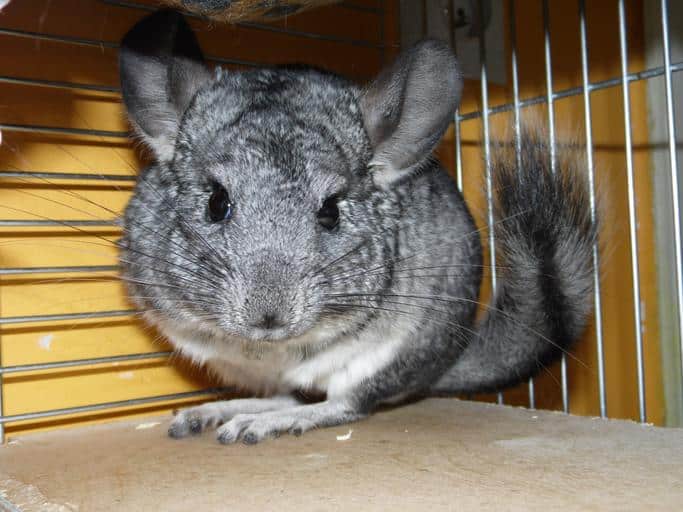
In Part 1 of this article, we talked about how to choose a pet chinchilla, and how best to house him. In this section, we will discuss the proper ways to make sure your new friend stays healthy. It’s up to you, the owner and caretaker, to ensure that your pet is well cared-for. Here, I will give you the information you need to do so.
Food:
Under no circumstances should a chinchilla be fed packaged “chinchilla food” from a pet store. These feed are usually stale, and contain bits of fruit and other treats that are dangerous if consumed in excess by chinchillas. I don’t believe the companies that sell this stuff should be allowed to continue churning it out, but thankfully, high-quality, healthful alternatives exist. You can find Mazuri, Tradition, or Oxbow brands at feed stores, or at those companies’ web sites, and it is not much more expensive than the garbage that is sold in pet stores.
Chins also require a constant supply of fresh timothy hay, also available at feed stores. Packaged hay can be fed, but is generally not fresh, and is many times more costly than buying a bale from a feed store.
Treats are not necessary for chins, but if you wish to give them a raisin or a Cheerio from time to time, they will love you for it! Just remember to limit their treats to one raisin, twice a week or less. More can cause severe illness, and does not contribute to their nutritional needs.
A bottle of fresh water must be available at all times, preferable not tap water, which can contain chemicals and bacteria which are dangerous for small animals.
Handling:
Chinchillas love playtime, and some will learn to jump into their owners’ hands once their cage door is opened. Most prefer not to be cuddled, but will always appreciate being allowed into a chin-proofed area to play. Remember that chins will chew on anything they can get their teeth on, so make sure the area where they play does not have loose wires, accessible electrical outlets, or Grandma’s heirloom table! Also make certain your little friend cannot escape from the area, and supervise his playtime whenever he is out of his cage. If you are fortunate, you will have a chin who loves to cuddle and be scratched and petted. Enjoy this! It is an honor for him to trust you so well.
Health and hygiene:
Despite your best efforts, things can still go wrong with your chin. One of the worst conditions that is found in chinchillas is malocclusion, which occurs when the animal’s back teeth begin to overgrow. They can grow up and down into the chin’s jaw and eyes, and if it is not caught early, will spell death for a chin. Observe your pet, and look for signs of discomfort. These can include refusal to eat, drooling, wet chest, eye pus, etc. Chins can also be prone to bloat, infection, and a host of other conditions. Locate a good veterinarian, with experience treating chinchillas. These visits can be expensive, so make sure you will have access to the funds needed to pay a vet in case your friend becomes ill.
One of the most important things you can do for your pet to ensure its good health, besides feeding it a fresh, healthful diet, is to provide it with a dust bath. You can find chinchilla dust at most pet stores, along with special containers to use as their bath. You can use any kind of container, as long as it is not made of something which can harm the chin, such as plastic.
Place the dust into the container, and place the container into your chin’s cage, or even into the bathtub. You pet will go inside and roll around in the dust, which besides being highly comical to watch, also helps them to keep their coats in top condition. Chinchilla’s fur is extremely dense, and this is the only way they have to keep it clean and oil-free. Remove the dust bath when your chin is done rolling, and do not allow free access to it. Too many baths can overdry their skin, and dust can get into the eyes and cause scratches. Change the dust every couple of baths, as the chins have a tendency to use the dust bath as a lavatory. You should never wash your chin in water. The fur is so thick that the water will not evaporate and dry, and mold can begin to grow in the coat.
Breeding:
There are few things more adorable than a baby chinchilla. The temptation to breed can be strong. However, breeding should not be attempted by any but the most experienced chinchilla owners, and pet-store chins should never be bred. It is impossible to know their history, and they can pass genetic conditions such as malocclusion to their offspring. Labor and delivery are highly dangerous for mother chinchillas, and you must have a great knowledge of her needs before you can assist your little mama with the birth of her kits. Once they are born, kits are susceptible to injury and disease, and some do not survive the birth itself. Leave this for the experts, until you have become one yourself. You will save yourself and your pets much pain and heartache.
The best single piece of advice I can give to a prospective chinchilla owner is this: Educate yourself before you bring home your new pet. Read the books. Visit the forums. Learn all you can about the little life you will be bringing into your home. There are several online communities where you will find true experts who freely share their knowledge and experience with chinchillas, and are happy to help newcomers to the world of chinchillas.
I hope the information in this article has helped you to make an informed decision about acquiring a chinchilla as a pet. As with any pet, there is a great deal of work that goes into the keeping of a chinchilla. They are by no means an “easy” animal to keep, but they are not terribly troublesome either, and the rewards of having them in your life are immeasurable. If you decide that a chinchilla is right for you, congratulations, but beware: It is nearly impossible to own one chin without desiring a whole herd of them!
Enjoy your pet, and love him well. He will repay you for years to come.





